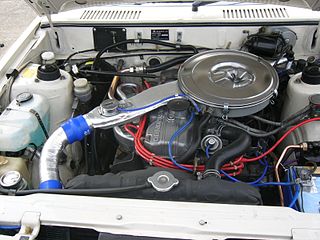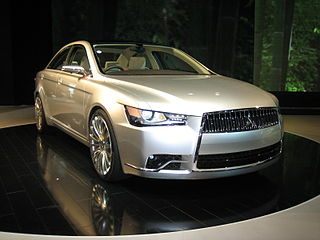Diamond-Star Motors (DSM) was an automobile-manufacturing joint venture between the Chrysler Corporation and Mitsubishi Motors Corporation (MMC). The name came from the parent companies' respective logos: three diamonds (Mitsubishi) and a pentastar (Chrysler). Diamond-Star Motors was officially renamed Mitsubishi Motor Manufacturing of America, Inc. (MMMA) in 1995, four years after Mitsubishi took sole control of the plant, and from 2002 to 2016 its official name had been Mitsubishi Motors North America, Inc. (MMNA) Manufacturing Division.

The Mitsubishi Galant Λ (Lambda) was a two-door, four-seater hardtop/notchback coupé built by Mitsubishi from 1976 to 1984. From 1978 it was exported under various names; as the Mitsubishi Sapporo in Europe and South America, the Dodge (Colt) Challenger and Plymouth Sapporo in North America and Puerto Rico, and the Chrysler Sigma Scorpion, Chrysler Scorpion and later the Mitsubishi Scorpion in Australia. It was also sold as a Sapporo in the United Kingdom under the Colt brand.

The Mitsubishi Lancer is a compact car produced by the Japanese manufacturer Mitsubishi since 1973.

Mitsubishi Colt is a nameplate from Mitsubishi that has been applied to a number of automobiles since 1962. It was first introduced with a series of kei and subcompact cars in the 1960s, and then for the export version of the subcompact Mitsubishi Mirage between 1978 and 2002. Chrysler, Mitsubishi's longtime partner, also used the name when applying its long-running practice of rebadging Mitsubishi vehicles as the Dodge and Plymouth Colt captive imports for the North American market between 1970 and 1994.

The Mitsubishi Astron or 4G5 engine, is a series of straight-four internal combustion engines first built by Mitsubishi Motors in 1972. Engine displacement ranged from 1.8 to 2.6 litres, making it one of the largest four-cylinder engines of its time. It became the first Japanese production engine to combine both electronic fuel injection (EFI) and turbocharging.

The Mitsubishi Sirius or 4G6/4D6 engine is the name of one of Mitsubishi Motors' four series of inline-four automobile engines, along with Astron, Orion, and Saturn.

The 6G7 or Cyclone V6 engine is a series of V6 piston engines from Mitsubishi Motors. Five displacement variants have been produced from 1986 to present day, with both SOHC and DOHC, naturally aspirated and turbo charged layouts. While MIVEC variable valve timing has also been implemented in some versions the 2.5, 3.0 and 3.5 L versions were also available with gasoline direct injection. This engine has been the flagship powerplant of the company except when they briefly built a V8 in 1999-2001. The staple of their high-end sedans, it was given twin-turbos for the Mitsubishi GTO, and became the most powerful car ever built by the company at the time.
Mitsubishi platforms are the automobile platforms used by Mitsubishi Motors for their production automobiles. Mirroring trends throughout the automotive industry, the company is reducing the number of distinct platforms, and increasing platform sharing across its ranges. Following DaimlerChrysler's purchase of a controlling stake in Mitsubishi in 2001, part of the subsequent cost-cutting drive initiated by Rolf Eckrodt upon his employment as chief executive officer of MMC was to reduce the number of platforms from twelve to six. Similarly, Stefan Jacoby, the CEO of Mitsubishi Motor Sales Europe, expressed concern in 2002 that the company would need to rationalize its platforms, even if the number of models sold were to increase.

The Mitsubishi Chariot is a small multi-purpose vehicle (MPV) manufactured and marketed by Mitsubishi from 1983 to 2003. Based on the SSW concept car first exhibited at the 23rd Tokyo Motor Show in 1979, the MPV derives its nameplate from chariots used by the ancient Greek and Roman Empires.

The Mitsubishi Galant VR-4 was the range-topping version of Mitsubishi Motors' Galant model, available in the sixth (1988–92), seventh (1992–96) and eighth (1996–2002) generations of the vehicle. Originally introduced to comply with the new Group A regulations of the World Rally Championship, it was soon superseded as Mitsubishi's competition vehicle by the Lancer Evolution, and subsequently developed into a high-performance showcase of the company's technology.

The Mitsubishi Debonair is a four-door luxury car, introduced by Mitsubishi Motors in 1964 to serve as their flagship passenger vehicle in the Japanese domestic market. The word debonair means gentle, courteous, suave, lighthearted, or nonchalant.

The Mitsubishi Colt Galant GTO was first shown as the Galant GTX-1 showcar at the 1969 Tokyo Motor Show. Sales began in November 1970, when it was the flagship hardtop variant of Mitsubishi Heavy Industries's then-new Colt Galant sedan. The nameplate was revived in 1990 for the Mitsubishi GTO, although this name was only used in the Japanese domestic market.
Reinforced Impact Safety Evolution (RISE) or Realized Impact Safety Evolution is the brand name of Mitsubishi's patented safety body construction system. It was first introduced in the 1996 Mitsubishi Galant. Initially designed to improve passive safety, the system has subsequently been developed to electronically integrate every aspect of car's active and passive safety features.

The Mitsubishi Galant Coupé FTO is a rear-wheel drive coupe produced by Japanese automaker Mitsubishi Motors from November 1971 to March 1975. "FTO" was meant to stand for Fresco Turismo Omologato, in a fine example of Japanese Italian. The compact Coupé FTO can be seen as the replacement for the earlier Mitsubishi Colt 11-F Super Sports.

The Mitsubishi Concept-ZT is a concept car developed by Japanese automaker Mitsubishi Motors, and first exhibited at the 40th Tokyo Motor Show in September 2007.

The Mitsubishi Lancer (A70) is the first generation version of Mitsubishi's long-running Lancer nameplate. When introduced in 1973, it filled the gap between the Minica kei car and the considerably larger Galant. It was a replacement for the Colt 1100, last sold in 1971. Although sedan production ended in 1979, vans continued on until 1985. This Lancer also formed the basis for the Lancer Celeste sports coupé of 1975 through to 1981. These Lancers were sold under a multitude of names in different markets.


















